The humble microphone—not the most glamorous piece of gear, but, for many DJs, it’s an essential tool that shouldn’t be overlooked. Not everyone uses, or needs to own, a mic. Here in the UK, using a mic as a DJ is kind of frowned upon in many circles. Where I live, in Newcastle, it’s typically relegated to the kind of bars and clubs that are chock-full of bachelorette parties and people in matching costumes throwing up on each other. That’s started to change a little in recent times, though. As more DJs see their EDM heroes jumping on the mic to hype up a crowd at massive events, the stigma attached to it has begun to dissipate, with ‘cool’ club and bar DJs more open to using a mic than they once were.
Of course, DJs in other fields have been rocking the mic quite happily forever; my impression from across the pond is that club DJs in the States are far better versed in using a mic to hype a crowd, and of course, I don’t need to even discuss how important mic usage is for mobile DJs.
As such, I’ve taken a close look at four microphones, strictly with DJ use in mind. Here are the specs I decided to focus on:
Wired: Wireless is great, but it has its downsides for DJing. A high-quality system can be very expensive, and will take up a lot of space in your bag if you have to carry it around. There’s also the consideration that in many venues, a spare XLR cable will be easy to find; a spare wireless transmitter, not so much. If you’re wandering around a massive stage, you might need wireless, but I’ve stuck to wired mics for this review.
Under $100: I suspected that spending over $100 on a DJ mic isn’t really necessary, and I’m happy to have found that my tests have supported this. All the mics tested here are absolutely usable for DJing, and I’m convinced that any extra money you could spend is redundant, unless you intend to use the mic for other purposes, too.
Dynamic: These are mics that need to take abuse, so dynamic is the way to go. There’s also no power required (batteries or phantom power). Condenser mics are great for the studio, but not so good for use on stage.
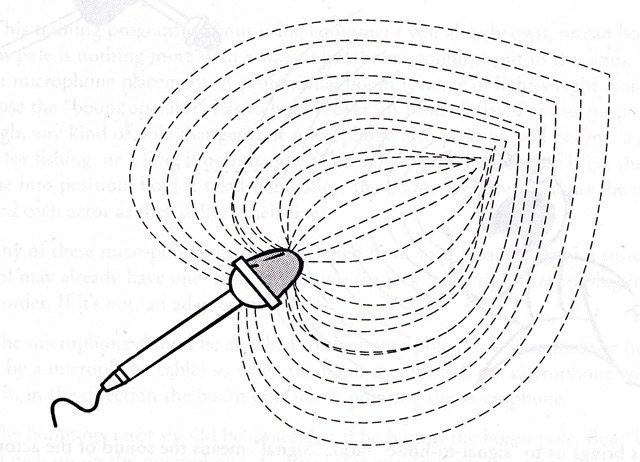
Cardioid pattern: By the time those other stipulations have been met, cardioid or super-cardioid pattern mics are the only options in the running. I’ll refer you to WikiPedia for more details about patterns, but to summarize, a cardioid pattern picks up sound from your mouth, and rejects sound from the rear, reducing feedback and unwanted noise. An omnidirectional pattern would not give you good results in the club.
Switched: Producers and live sound engineers will turn their noses up at mics with on-off switches; after all, you don’t need a switch if there’s a sound guy ready to hit the mute button on his big desk. But for DJ use, I prefer a switch—you don’t have to use it, but I find when using a mic handheld, it’s usually easier to control with the mic itself, rather than constantly reaching for a small button on your mixer.
Metal-bodied: Any plastic mic is straight out the window. A mic for DJing needs a solid metal body to cut down on handling noise—the noise made as you move your hand around on it the body. In the video, I simulate that rather excessively by tapping the mics, which is obviously a no-no, but it gives you an idea of how the different bodies deal with movement and vibration.
NOTE: WHERE’S THE SM58?
I’m sure that some readers might suggest that a comparison review of dynamic mics that doesn’t feature the Shure SM58 (which runs right around $100), is as flawed as a headphone roundup with no Sennheiser HD-25s. However, we decided on sticking to four mics, in order to cover each well enough, and I don’t think there’s much new to say about a mic which has been on the market for 40 years. I’ve used an SM58 many times, and it’s a great mic, deserving of its reputation. But we wanted to check out some more recent gear here.
NUMARK WM200 ($30)
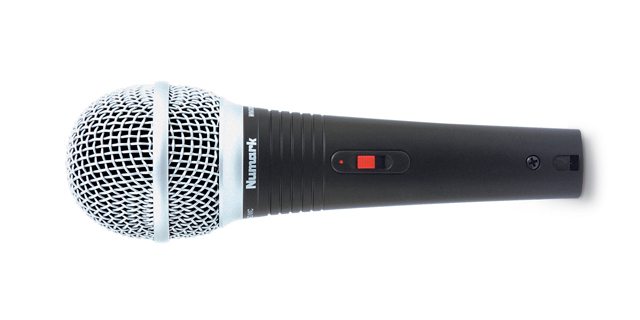
I approached the WM200 with a degree of skepticism. Could a $30 mic possibly be up to the job? Amazingly, yes, it is. For sure, the WM200 is easily the lightest mic in the test, and the amount of handling noise evident is much higher, as that light weight would lead you to suspect. But the build quality is decent enough, with my only qualm being the small little red on/off switch, which feels a bit more exposed and breakable than the inset switches on the AKG and Audio-Technica models. The switch also seems a little more noisy than the others, but that could just be a byproduct of the handling noise.
The sound quality is perfectly acceptable for DJing—it sounded just fine in the club and in my studio test. Numark doesn’t provide specs for it, but the sensitivity appears to be quite high, so you don’t need a lot of added gain with the WM200. That does mean a little more care needs to be taken to avoid feedback, though.
You get a lot for your $30, too: A hard plastic foam-lined case houses the WM200, a wall mount (weird), and an unbalanced XLR-jack cable. If $30 is the absolute most you can spend on a mic, or you want something to keep in your bag for emergencies, then you can’t really go wrong with the WM200. It streets ahead of the plastic junk you’ll find for at Radio Shack for $20, and held its own very well against the more expensive competition here.
SENNHEISER E840 ($130)
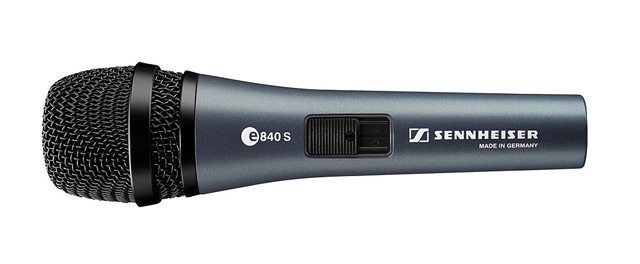
The current model in Sennheiser’s range that fits our criteria for this review is the E835S; street price around $100, has an onboard switch. Unfortunately, Sennheiser UK didn’t have a review unit to send me, so I got the E840 instead. And it’s a very good microphone. Heavy, solid construction, not too much in the way of handling noise; the super-cardioid pickup pattern was very good at rejecting feedback when I tried it at a venue.
Check out the video for an idea of how it sounds; I had no complaints there. It sounds maybe a little more dull than the other mics on test, to my ears, but clean, and clarity is good. It comes with the basic accessories, a pencil-case-type zip-up bag, and an adaptor clip for use with a stand.
In terms of differences compared to the E835S, there’s no switch, so I can’t comment on how silent (or noisy) that is, and the model tested has a slightly wider frequency response in the very top end. Otherwise, Sennheiser have assured me the build and sound are the same.
The current switched version of the E840—the E845S—has a street price of around $150, so however good it is, it simply can’t be a winner in this particular test. Based on using the E840, though, I’m confident you’ll get great results with the E835S. Let us know in the comments if you’ve used one, and what you think of it.
AUDIO-TECHNICA PRO 41 ($50)
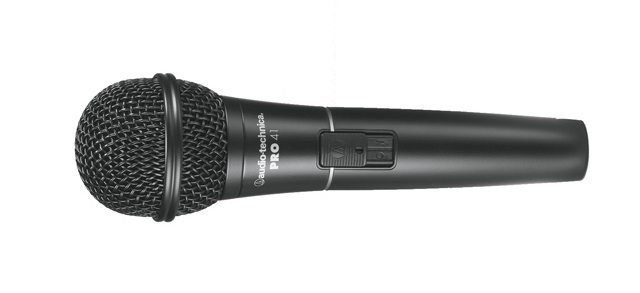
Another mic at the more budget end of the scale, the PRO 41 is pretty impressive for its street price of around $50-60. It’s not quite as heavy as the AKG or the Sennheiser, but more reassuringly weighty than the Numark, the build quality feels very good for the money.
The MagnaLock on/off switch is inset, with a nice action, albeit not completely silent. Sound-wise, handling noise is present, but not excessive, and the cardioid (as opposed to super-cardioid) pattern seemed to make very little difference in my live tests, or in the lab. It has a nice bright sound, which I found worked well for my voice when trying to cut through loud music.
In the box you get a stand clip, a pencil case, and a 15-foot XLR-XLR cable—a lot of value for your 50 bucks.
I almost feel bad, because I don’t really have much more to say about the PRO 41. It’s a solid, well-made, good-value mic with decent sound quality. Like a mid-range saloon car, it’s doesn’t get my heart pounding, but it does the job at hand (no pun intended) very well indeed. Audio-Technica have a massive range of mics, from the super-cheap to the crazy expensive, and no doubt there are other products in their range which will have mic fetishists foaming at the mouth, but for $50, the PRO 41 is a great choice for a DJ looking for a mic that will take some abuse and not break the bank.
AKG D5S ($95)
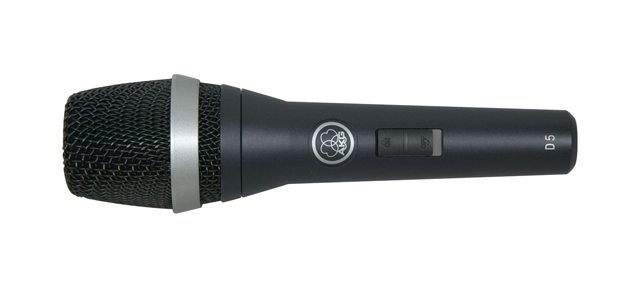
At the top end of our $100 price limit sits the D5S. There’s no cable in the box with this one, but you do get the usual clip and pouch, plus a sticker. (I like stickers. All manufacturers should put stickers in with everything, in my opinion.)
Visually, it’s very striking, with the angular shape of the body and capsule, and the silver color accents. That sharp, sudden tapering of the body not only looks good, it feels great, too, almost offering a little physical reminder to keep your grip away from the capsule, as you should, rather than clutching it like a bad drum & bass MC after a few too many cans of Red Stripe.
Sound quality with mics is always subjective, as everyone’s voice is different, but I found the D5S most pleasing to my ears of all the mics I tested. It’s a super-cardioid pattern, and seemed pretty good at avoiding feedback, too.
The inset on/off switch has a slightly shorter throw than the one on the PRO 41, and feels a little more ‘clicky.’ It does exhibit a small amount of noise when switched, but like the Audio-Technica, it’s nothing that will cause you issues in a live setting. The same goes for handling noise, which is about equal to the Sennheiser; not noticeable unless you something dumb, like tapping it (as I do in the video review).
There’s just something about the feel, and the balance, of the D5S that just appealed to me. Ergonomics and design go a long way with fairly simple products like mics, and thankfully the D5S has the audio chops to prove it’s not just a pretty face.
WRAP-UP
As I stated earlier, the Sennheiser E840 can’t be the winner of this round-up; I suspect the E835S might have been a strong contender, but without getting my hands on it, I can’t recommend it outright. I can suggest that you check out the Sennheiser range, though, as the E840 I tested is indeed an impressive bit of gear.
Of the other three, my winner has to be the AKG D5S. That might seem to be a given, as it’s three times the price of the WM200, and double that of the PRO 41, but what surprised me was just how good those cheaper options turned out to be. The AKG feels, sounds, and looks like every cent of its $100 price tag, but the Audio-Technica and Numark models will do a good job for any DJ, too.
Now, this was not a long-term test; I have used and abused these mics, but only for a short period of time. Seeing as there’s very little technological difference between this group of quite similar mics, it’s worth understanding that when you pay a bit more, you’re paying for build quality above all else. So unless you’re only a very occasional mic user, it’s probably worth reaching as close to that $100 threshold as you can, because $100 will get you a very nice mic indeed.
But if you can’t, don’t sweat it. I used the WM200 at one gig, the PRO 41 at another, and the AKG at the next, and I’m pretty sure I was the only person in the room who noticed any difference, and that’s because I was holding them.
Chris Brackley

Geen opmerkingen:
Een reactie posten